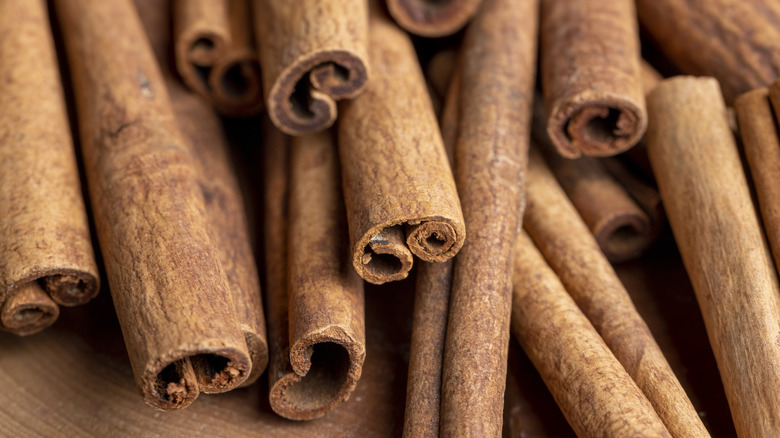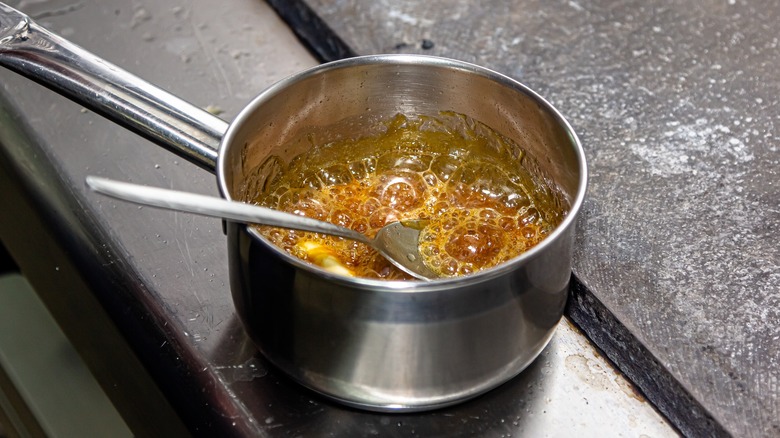A Pinch Of This Spice Will Take Your Butterscotch To A New Level
Butterscotch sauce is the dream for anyone with a sweet tooth: A creamy, smooth, and rich sauce that complements ice creams, puddings, and cakes. Butterscotch sauce usually contains four main ingredients: brown sugar, butter, heavy cream, and salt. Caramelization occurs when sugar is heated, and when butter and heavy cream are added, you'll be left with an intense toffee flavor balanced out by adding salt.
If you're making butterscotch sauce at home, there is one ingredient that your sauce might be missing: cinnamon. This might not come as a surprise, as pairing cinnamon and sugar is nothing new. Whether it's in your cinnamon donuts, snickerdoodle cookies, or classic apple pie, cinnamon and sugar are a combination that you'll find over and over. Adding cinnamon to your butterscotch will give the existing butterscotch flavors a warm hug. It's as simple as mixing in ½ teaspoon of cinnamon when adding the sugar and salt to your butterscotch sauce. If you want to further intensify your butterscotch, feel free to experiment with more cinnamon.
Cinnamon will add warmth to your butterscotch
Adding cinnamon to your butterscotch sauce might just mean you'll never go back. Cinnamon flavor notes bring warmth and earthiness to your dishes, especially when combined with the sugar in the butterscotch sauce. Ground cinnamon is the easiest form to add as it does not require any time to release its flavor. That's because it can cover a wider surface area as a powder, as opposed to a single cinnamon stick. However, if you have cinnamon sticks you've been wanting to use, you can add one when bringing your mixture to a boil. Remove the stick when your butterscotch is ready and cooled. The flavor might be more subtle, but the warm and woody notes will still infuse into your butterscotch sauce.
If you're wondering how to serve your cinnamon butterscotch sauce, think further than butterscotch pudding or vanilla ice cream. One creative way to use butterscotch sauce is as a dip. Next time you're having a chocolate fondue, add a bowl of butterscotch sauce and dip your fruit, marshmallows, or pretzels right in. Using butterscotch as a dip will emphasize the sweetness in fruits or marshmallows while adding some woody flavors from the cinnamon. Dipping in savory foods like pretzels is the perfect way to balance out the saltiness with some sweet butterscotch sauce.
Tips to make the best butterscotch sauce
While using cinnamon in your butterscotch might be down to personal preference, a lump-free and tasty butterscotch is more of a universal desire. To achieve a smooth and creamy consistency with your butterscotch sauce, avoid over-stirring the sugar when melting it into the butter. If you do, you risk your sauce separating. You might be wondering if there's a simple fix to thicken your butterscotch sauce. The trick is to let it simmer without stirring for 3 minutes. Not enough simmering will leave you with a liquid-like sauce. Keep your eye on the clock, as simmering over 3 minutes might give you a sauce that is too thick.
If your finished sauce still has a few sugar clumps, you can smooth it out by running it through a mesh sieve before it cools. Be sure to have all your ingredients measured and ready to go before you start cooking your sauce. Butterscotch recipes move quickly from one step to the next, so it's in your best interest to be prepared. Keep your pan on low to medium heat at all times. Otherwise, you risk burning your butter or sugar, which might not be the type of butterscotch sauce you're after. Finally, don't be afraid to adjust the final taste of your sauce. Let a spoonful of the sauce cool before trying and evaluating whether you need more salt, cinnamon, or another flavor you might be using.


